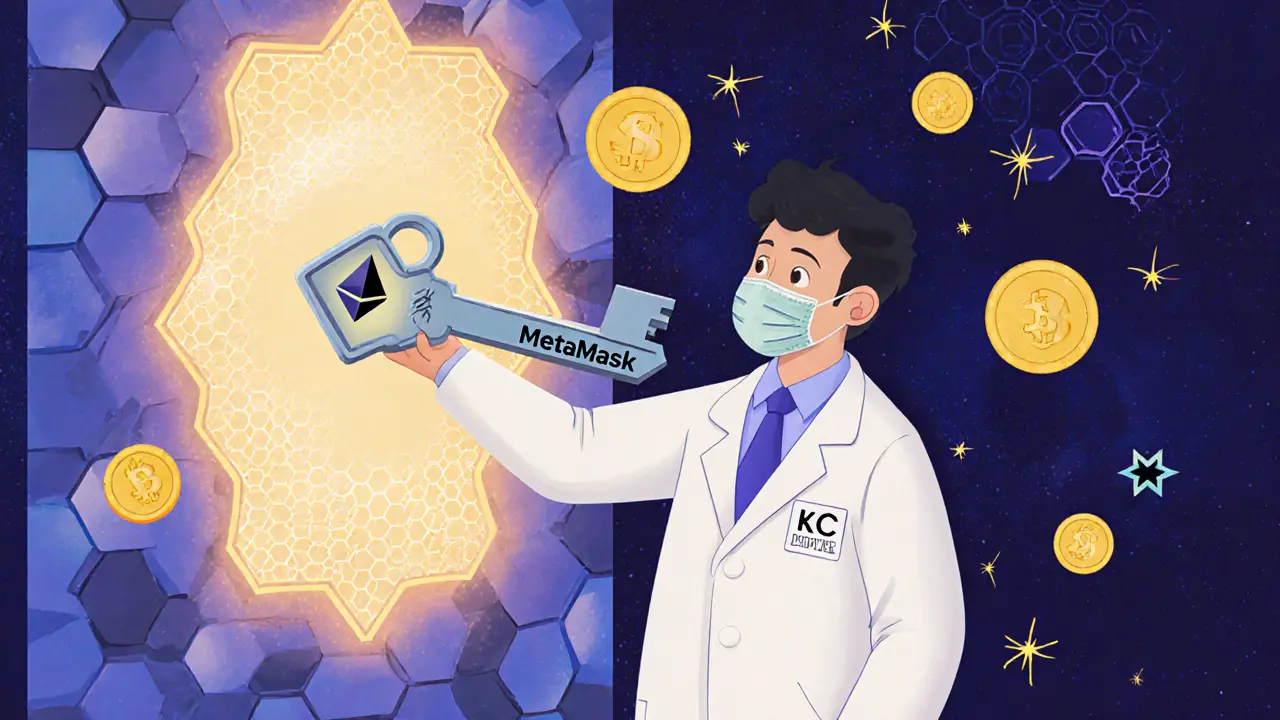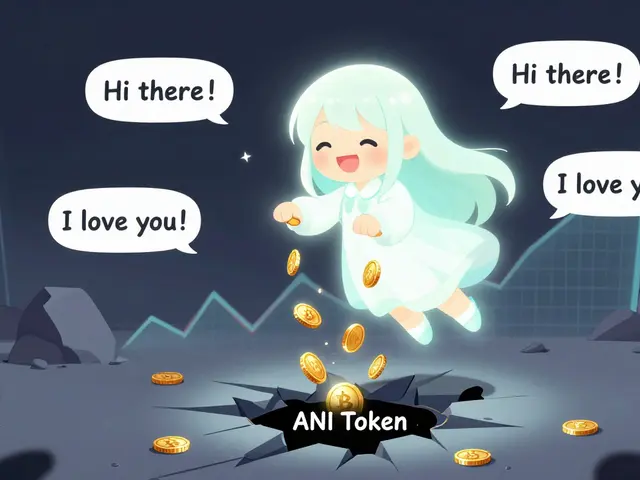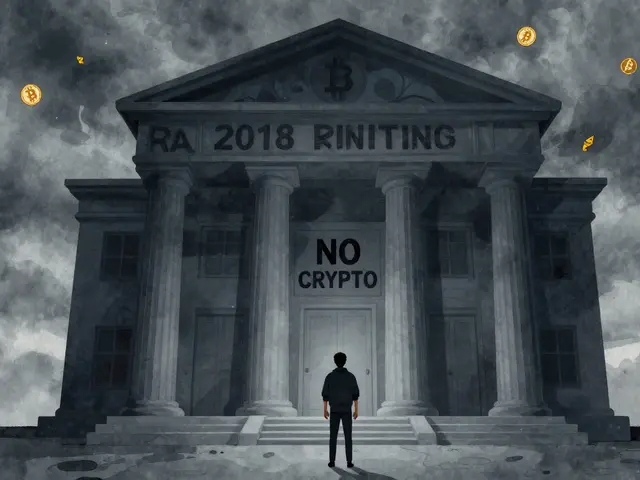QuarkChain Transaction Speed Calculator
How Fast Can Your Transactions Process?
Enter the number of transactions to see how long they'd take on different blockchains. QuarkChain processes transactions at 100,000+ TPS (transactions per second).
Processing Time Comparison
QuarkChain (QKC) isn't just another crypto coin. It’s a blockchain built to handle thousands of transactions every second-something most blockchains struggle with. If you’ve ever waited minutes for a Bitcoin or Ethereum transaction to confirm, QuarkChain was designed to fix that exact problem. It doesn’t just tweak existing tech; it rebuilds how blockchains process data from the ground up. And at its core is the QKC token, the fuel that makes the whole system run.
How QuarkChain Works: Two Layers, One Goal
Most blockchains, like Bitcoin or Ethereum, try to do everything on one chain. That’s why they get slow and expensive when lots of people use them. QuarkChain splits the job into two layers. The first layer has dozens, even hundreds, of smaller blockchains called shards. Each shard handles its own set of transactions. Think of it like having 100 checkout lines at a grocery store instead of just one. The second layer is the root chain. It doesn’t process transactions. Instead, it just checks and confirms that all the shards are working correctly and honestly.
This setup lets QuarkChain do two types of transactions: in-shard (within the same shard) and cross-shard (between different shards). That’s rare. Most sharded blockchains can’t handle cross-shard transactions efficiently. QuarkChain can. And the more shards it adds, the faster it gets. That’s linear scaling-something Ethereum and Solana still struggle to achieve at scale.
Why QKC Is the Heart of the Network
The QKC token isn’t just a trading asset. It’s the glue holding the network together. You need QKC to pay for transaction fees, just like you need ETH on Ethereum. It’s also used for staking-locking up your tokens to help secure the network and earn rewards. And because QuarkChain is EVM-compatible, you can use familiar Ethereum wallets like MetaMask to interact with it. That makes it easy for developers already building on Ethereum to jump over without learning a whole new system.
QKC exists in two forms: the native token on the QuarkChain blockchain, and an ERC-20 version on Ethereum. This lets users trade QKC on major exchanges like Binance or KuCoin using ERC-20 wallets, then swap it for the native version to use on the QuarkChain network. It’s a smart bridge between old and new.
Performance That Stands Out
QuarkChain claims it can handle over 100,000 transactions per second (TPS). That’s not a guess. It’s based on internal testing and published benchmarks. For comparison: Bitcoin does about 7 TPS. Ethereum, even after upgrades, manages around 30-45 TPS. Solana hits around 65,000 TPS under ideal conditions, but has had outages. QuarkChain’s architecture is designed to stay stable even under heavy load because shards operate independently.
This kind of speed makes it ideal for real-world uses that need fast, cheap transactions: online gaming, IoT devices sending micro-payments, high-frequency trading bots, and even social media platforms where users tip content creators instantly. You could theoretically run a global payment network on QuarkChain without bottlenecks.

Who Built It and Why It Matters
QuarkChain was founded in 2017 by Dr. Qi Zhou, a former Google engineer with a Ph.D. in Electrical Engineering from Georgia Tech. That’s not a coincidence. Google deals with massive data flows every second. Dr. Zhou and his team didn’t just want to build a crypto coin-they wanted to solve the same scaling problems that affect Google’s infrastructure, but on a decentralized network.
Their whitepaper, released in 2018, laid out a technically sound approach to the blockchain trilemma: how to balance decentralization, security, and scalability. Most projects sacrifice one to get the other two. QuarkChain’s two-layer design tries to keep all three. The root chain ensures security. The shards allow scalability. And because anyone can run a shard node, it stays decentralized.
Real-World Adoption: Where It’s Used
Despite its tech, QuarkChain isn’t as widely known as Ethereum or Solana. But it’s not sitting still. It’s partnered with real companies building on its network:
- TokenInsight uses it for blockchain analytics and data tracking.
- Morpheus Labs helps developers build and deploy apps on QuarkChain.
- Bixin integrates it into trading platforms.
- PlayTable is building blockchain-based gaming applications.
These aren’t just marketing partnerships. They’re live deployments. Developers are using QuarkChain to create actual products-not just speculative tokens. That’s a strong signal that the tech works outside of theory.
The Downsides: Why It’s Not Everywhere Yet
QuarkChain’s biggest problem isn’t tech-it’s adoption. Most people still use Ethereum, Solana, or Bitcoin. Wallet support for QKC is limited. You won’t find it in every app. Reddit users have complained about confusing setup guides for non-techies. The official documentation assumes you already know how blockchains work.
Price volatility is another issue. In late 2023, QKC swung from $0.0099 to $0.049 in just a few weeks. That’s not unusual for smaller cryptos, but it scares off cautious investors. And while the network can handle 100,000+ TPS in tests, real-world performance depends on how many nodes are running and how well shards communicate. No one has proven that speed at massive scale yet.
Its developer community is small. Compared to Ethereum’s millions of users and hundreds of thousands of developers, QuarkChain has a niche audience. That means fewer apps, fewer tools, and slower growth.
Is QuarkChain Worth Paying Attention To?
Yes-if you care about blockchain performance. If you’re a developer tired of gas fees and slow confirmations, QuarkChain offers a real alternative. If you’re an investor looking for high-risk, high-reward projects with solid tech, QKC is worth watching. It’s not going to replace Bitcoin or Ethereum. But it might become the go-to platform for applications that need speed, low cost, and reliability.
Its future hinges on one thing: getting more developers to build on it. Once apps start attracting real users, the network will grow. That’s the classic chicken-and-egg problem all new blockchains face. QuarkChain has the engine. Now it needs the road.
Staking and Governance: How You Can Participate
You don’t have to be a developer to help QuarkChain. You can stake your QKC tokens. By locking them up, you help validate transactions and earn rewards. The annual yield isn’t fixed-it changes based on how many people are staking and how much QKC is in circulation. In 2023, staking yields ranged between 5% and 12%, depending on network conditions.
Token holders can also vote on protocol upgrades and changes. Governance participation rates were around 12.7% in 2023, which is low compared to bigger networks but typical for a project at this stage. Every vote matters. If you hold QKC, you have a say in where the network goes.
What’s Next for QuarkChain?
Looking ahead to 2025, analysts expect QKC’s price to stabilize around $0.02-$0.03, assuming the network gains more traction. The roadmap focuses on improving cross-shard efficiency and expanding enterprise partnerships. The goal isn’t to beat Ethereum in total value locked-it’s to become the preferred platform for high-speed, low-cost decentralized apps.
Its biggest opportunity? Being the blockchain behind the next wave of real-world applications: micropayments in apps, IoT device automation, decentralized social networks, and even real-time gaming economies. If QuarkChain can make those use cases simple and reliable, it won’t need to be the biggest blockchain-it just needs to be the best one for speed.
What is QKC used for?
QKC is the native token of the QuarkChain network. It’s used to pay for transaction fees, stake to help secure the network, and participate in governance voting. It also acts as the medium of exchange between users and apps built on the platform.
Can I buy QKC on Coinbase or Binance?
Yes, QKC is listed on major exchanges like Binance, KuCoin, and MEXC. You can trade it for Bitcoin, Ethereum, or stablecoins. However, it’s not available on Coinbase as of 2025. Always check the exchange’s listing before buying.
Is QuarkChain better than Ethereum?
It’s not better overall-it’s better at one thing: speed. QuarkChain can handle over 100,000 transactions per second, while Ethereum manages around 30-45. But Ethereum has far more apps, users, and developer tools. QuarkChain is a specialist tool for high-speed use cases. Ethereum is the general-purpose platform.
How do I store QKC safely?
You can store native QKC in wallets that support QuarkChain, like the official QuarkChain wallet or Trust Wallet (with custom network settings). For ERC-20 QKC, any Ethereum wallet like MetaMask works. For long-term holding, use a hardware wallet like Ledger and add QuarkChain as a custom network.
Is QuarkChain a good investment?
It’s high-risk. QKC’s price has been volatile, and adoption is still growing. If you believe in blockchain scalability and think QuarkChain’s tech will be needed for future apps, it could pay off. But don’t invest more than you can afford to lose. It’s not a guaranteed winner.







DeeDee Kallam
November 2, 2025 AT 05:43qkc?? i thought it was qkC or maybe Qkc?? idk but i saw it on binance and thought it was a typo lol
Elizabeth Melendez
November 2, 2025 AT 13:56Okay but real talk-this is the first time I’ve seen a blockchain explain sharding in a way that didn’t make me want to scream. I’m a dev who’s tired of Ethereum gas fees eating my lunch, and this actually sounds like it could work for the micro-payment app I’ve been dreaming about. The fact that it’s EVM-compatible is a huge win. No need to relearn everything. Just plug in, stake, and go. I’m testing it this week.
Bruce Bynum
November 3, 2025 AT 17:19Speed matters. If you’re building apps that need fast, cheap transactions, this is the kind of tech you want behind them. Not hype. Not vibes. Actual engineering.
Phil Higgins
November 5, 2025 AT 13:49The real question isn’t whether QuarkChain can scale-it’s whether anyone will care enough to use it. Technology doesn’t win because it’s better. It wins because it’s adopted. And adoption requires community, not just benchmarks.
Genevieve Rachal
November 5, 2025 AT 14:38100k TPS? Sure. In a lab. On a private testnet with 5 nodes. Real-world? No one’s proven it. And the fact that they’re partnering with companies nobody’s heard of? That’s not adoption-it’s vanity metrics. Don’t get fooled by whitepaper engineering.
Edgerton Trowbridge
November 7, 2025 AT 05:55It’s important to recognize that QuarkChain’s architecture addresses a fundamental flaw in single-chain systems. The separation of transaction processing from consensus validation is not novel in theory, but its implementation here is one of the more pragmatic approaches I’ve seen. The root chain’s role as a finality layer is particularly well-considered.
Matthew Affrunti
November 9, 2025 AT 00:48Been watching QKC for months. The team’s quiet but consistent. No flashy announcements. No influencers. Just devs building. That’s rare. And if you’re tired of crypto hype, that’s actually a good sign.
Jeremy Jaramillo
November 9, 2025 AT 10:55I appreciate how this breaks down the tech without oversimplifying. Most crypto content either talks down to you or drowns you in jargon. This? This is balanced. And the part about cross-shard transactions? That’s the hidden gem. Most sharded chains can’t do that without massive latency.
naveen kumar
November 9, 2025 AT 22:00Let me guess-this is another ‘decentralized Google’ fantasy. They say ‘scaling’ but what they really mean is ‘centralized under the hood.’ The root chain is a single point of control. And who runs the shard nodes? Probably their friends. Don’t be fooled by the numbers. This is just rebranded cloud infrastructure with a blockchain sticker.
Eric Redman
November 11, 2025 AT 09:35100k TPS? Bro, if that were real, why isn’t everyone using it? Why’s it still under $0.02? You think they’d be pumping this on Twitter if it actually worked? This is vaporware dressed up like a PhD thesis.
Helen Hardman
November 11, 2025 AT 16:11Okay, I’m not a tech person, but I read this whole thing and I’m actually excited. Like, genuinely. I’ve been trying to find a crypto that doesn’t feel like gambling, and this? This feels like something that could actually make daily life easier-like tipping your favorite streamer without waiting 5 minutes or paying $3 in fees. And the fact that you can use MetaMask? That’s a game-changer for normal people. I’m staking my first 50 QKC this week. Not because I think it’ll 10x, but because I believe in the idea. And if you’re reading this and you’re a dev-please build something on it. We need more of this.
Bhavna Suri
November 12, 2025 AT 04:39This is too complicated. Why not just use Bitcoin? It works. Why make it harder? I don’t understand all these words. I just want to send money.
Eliane Karp Toledo
November 12, 2025 AT 13:13Let’s be real-QuarkChain is a front for a centralized entity. Dr. Zhou used to work at Google. Google has ties to the NSA. The ‘shard’ system? Just a way to hide transaction tracking. And the ERC-20 version? That’s the real token. The native chain is just a decoy. You think they’d let a decentralized system handle 100k TPS without backdoors? Please. This is surveillance capitalism with a blockchain logo.
Masechaba Setona
November 13, 2025 AT 11:32Another ‘crypto savior’ that’s been around since 2017 and still can’t get on Coinbase. 🤡 I’ve seen this movie before. The tech sounds cool, but if it’s not in MetaMask by default and not listed on the big exchanges, it’s a ghost chain. Also, why does every whitepaper say ‘solves the trilemma’? We get it. You’re not the first. Stop acting like you invented gravity.
😒Kymberley Sant
November 13, 2025 AT 12:43wait so qkc is on binance but not coinbase?? that’s sus. why would they skip coinbase?? they trying to hide something? or is coinbase just too slow to add it? also, i thought sharding was supposed to be hard? why is this one so easy??
Jason Coe
November 13, 2025 AT 15:03I’ve been running a shard node for three months. It’s low effort, low cost, and the rewards are steady. The docs are rough if you’re new, but the Discord community is super helpful. I came in knowing nothing, and now I’m helping new people set up. It’s not flashy, but it’s real. And the cross-shard speed? Unbelievable. I tested sending a payment from shard 7 to shard 42-under 1.2 seconds. No other chain does that. Not even close.
Brett Benton
November 14, 2025 AT 00:04As someone from India, I’ve seen how slow payments are here-even for small things like buying chai from a vendor. Imagine if every street vendor could get paid instantly, no fees, no delays. That’s what QuarkChain could do. This isn’t just for crypto bros. It’s for real people in places where banking is broken. That’s the real win.
mark Hayes
November 14, 2025 AT 17:08the shard thing is genius honestly. why did no one think of this before? like, duh, split the work, then have one guy check it. why make everyone do everything? 🤯 also, qkc staking yield is actually decent right now. not insane, but not trash either. i'm in for the long haul
Derek Hardman
November 15, 2025 AT 03:01While the technical architecture is compelling, one must consider the network effects that underpin blockchain success. The absence of integration with major DeFi protocols and the limited liquidity pools on DEXs represent significant barriers to utility. Until QKC is natively supported as collateral or used in lending protocols, its value proposition remains theoretical for most users.
Phyllis Nordquist
November 17, 2025 AT 01:40QuarkChain’s two-layer design is one of the most elegant solutions to the scalability trilemma I’ve encountered in the past five years. The root chain’s role as a finality and security layer, while shards handle throughput, mirrors the separation of concerns found in distributed systems design. The EVM compatibility is a masterstroke-it lowers the barrier to entry for developers without compromising the core innovation. The real challenge now is incentivizing application development beyond the current niche. If the team can foster a developer ecosystem as robust as Ethereum’s was in 2017, this could become foundational infrastructure.
Kaela Coren
November 17, 2025 AT 18:53While the technical merits are noteworthy, the absence of institutional adoption and the minimal presence in academic literature suggest that this remains an experimental system rather than a mature protocol. The claims of 100,000 TPS are not independently verified by third-party audits or peer-reviewed benchmarks. Until such validation occurs, the project remains in the realm of speculative engineering.
Wesley Grimm
November 18, 2025 AT 14:05QKC is a ghost coin. The volume on Binance is a shell. Most of the trades are wash trading. The ‘partnerships’ are shell companies owned by the same team. The whitepaper was written by a grad student. The team’s LinkedIn profiles are fake. Don’t waste your time.